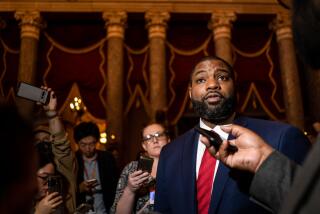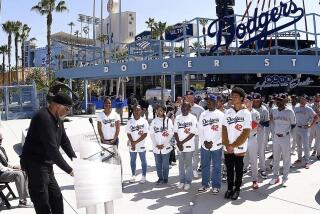Those Who Lived It Recall the Oppressive Era of Jim Crow
- Share via
Black and white--that’s how many people view the segregated Jim Crow era of American history, both in terms of race and the experiences for those who lived through it, according to the producer of a pair of upcoming radio documentaries examining the period.
But those eight decades before the civil rights movement were not just a time when blacks and whites had their places, and laws--written and unwritten--kept them there. It was also a time that nurtured the discontent and rebellion that flowered in the 1950s and ‘60s. The stories from the years between Reconstruction and the civil rights movement are far more varied and nuanced than many people realize, according to Stephen Smith, producer of “Remembering Jim Crow” and “Radio Fights Jim Crow,” airing Feb. 18 on KPCC-FM (89.3) at 7 p.m.
“I was familiar with the conventional thinking of the Jim Crow period, that it was a monolithically oppressive period,” said Smith, who has a master’s degree in African American studies from the University of Chicago. Upon embarking on this project, “one of the things that stood out from the beginning was the complexity that added to this simplistic vision.”
“Remembering Jim Crow” arose from a decade-long oral history project at Duke University’s Center for Documentary Studies. Graduate students from around the country fanned out across the South with tape recorders, interviewing aging people, both black and white, about their memories of the Jim Crow era. As most of the subjects were in their 60s, 70s and 80s, the researchers wanted to capture those voices before they were gone. Smith built on those 1,200 interviews to create an hourlong program, produced by American Radio Works, the documentary arm of Minnesota Public Radio and National Public Radio News.
Shows Surprise Younger Listeners
For those whose perspective of the Jim Crow South comes from Faulkner or “To Kill a Mockingbird,” Smith said the program will add complexity and sophistication to that view.
“The people who are most often surprised are the people in their teens or early 20s,” he said, noting that youths “find these stories sort of breathtaking” in their cruelty and in the realization that such racism and segregation flourished so late in the century.
“So many people view it as part of a bygone era, for which there’s no connection today,” Smith said. But “a lot of the problems we face today are rooted more in the Jim Crow period than in the slavery period. This is really the period in which the relationship between whites and blacks in an emancipated country was really defined.”
During this time, the South was ruled by a Byzantine code derived from laws, courts and custom. It was a time of lynchings and other atrocities, and one in which black parents advised their children how to act to avoid confrontation: stepping off the sidewalk to allow whites to pass, entering a store through the back door. It was a time of continual stress, waiting for the next daily indignity or injustice, when not adding a “sir” to your “thank you” would warrant a slap across the face from an insulted pharmacist.
As Ann Pointer, of Tuskegee, Ala., told her interviewer, “I want to tell you how horrible it is when everything you do, the [white] man’s got to approve it.”
African American men--except teachers and pastors--were eyed suspiciously if they wore a tie on any day except Sunday. Blacks were not supposed to refer to other blacks as “Mr.” or “Mrs.” when talking to whites, instead using their first names. Blacks were disenfranchised from the political process by arcane voting tests, in which illiterate voting registrars would disqualify African American college professors for missing a period or not staying within the lines. A store sold Coca-Cola to whites, giving blacks Pepsi even if they asked for Coke.
In Albany, Ga., a popular Sidney Poitier film filled the local movie theater to overflowing, so the manager evicted several black youths from the balcony--the “colored section”--so whites could sit there when the floor seats ran out.
And it was a time when white employers used generic forms of address such as “Uncle” or “Auntie,” “Jim” or “Susie,” regardless of a black employee’s real name, out of condescension or disdain or laziness.
One interviewee, Olivia Cherry of Chesapeake, Va., said she was “a spunky kid” who simply ignored bosses who wouldn’t address her correctly, such as a farmer whose raspberries she was picking.
“I just kept on working. He said, ‘Susie, don’t you hear me talking to you?’ I said, ‘I told you before, my name is Olivia. Olivia. Can you say that?’”
Such stories show that, even in the smallest of ways, African Americans were rebelling against their oppression long before the civil rights movement, said William H. Chafe, one of the directors of Duke’s oral history project, as well as the university’s dean of arts and sciences and vice provost for undergraduate education.
“The radio show certainly shows the fire and the anger and the horror of these experiences,” Chafe said. “It brings home the daily-ness of what this reality was. That needs to penetrate people’s historical sensibilities.”
In doing so, he added, the program may help people understand the indignity and injustice of racial profiling, or illuminate the gulf between the Muslim and Judeo-Christian worlds--one generally more affluent and powerful than the other, and the other feeling resentful or oppressed.
A Way to Bring History to Life
“Hearing the voices of the folks who actually lived the history brings the history to life the way nothing else can. This makes this really compelling radio,” said Paul Glickman, KPCC news director, who said the station aired the programs when they debuted last fall and decided to re-run them for Black History Month.
“It’s crucial that these young people hear these stories before they’re gone,” added Joseph E. Holloway, professor of pan-African studies at Cal State Northridge. “Most of the young people now were born after the civil rights movement. They don’t have a clue.”
In 1960, as a teen driving with his family from Los Angeles to visit relatives in Louisiana, Holloway saw a vivid image of the period’s savagery. They pulled into Waco, Texas, just as a mob was burning a black man to death, then turned and chased them.
“They don’t know about the struggles, the sacrifices. They weren’t born at a time when segregation was here. They could not believe these things could have happened at one time,” Holloway said. “There’s a disconnect. They’ve got to see those who struggled before them, and made it possible for them to come to integrated schools.”
Broadcasts Attempted to Heal Tensions
The second hourlong program, “Radio Fights Jim Crow,” focuses on broadcast programs from the World War II era that tried to heal racial and ethnic tensions of the time and counteract the “Amos ‘n’ Andy” stereotypes common in the media.
“It’s a fascinating example of how the civil rights movement started long before the 1950s,” producer Smith said, when activists realized they needed to get their message out via the mass media--first radio, and later television.
The federal government supported the programs because officials knew the war effort required that blacks and whites work in harmony at defense plants, he said. They also wanted to counteract Axis propaganda about racial inequality, which they feared would turn minorities into a fifth column of enemy sympathizers.
Smith said the shows were “basically explaining to white Americans that African Americans are not just human, but they are Americans. They were conveying a message that was critical, that blacks were the moral and intellectual equals of whites.”
“People say, ‘It’s so far behind us, what’s the point?’” Chafe said. “It’s not so far behind us, and that’s the point.”


